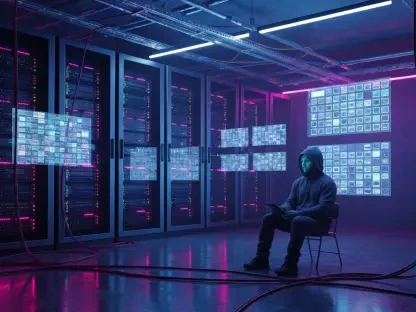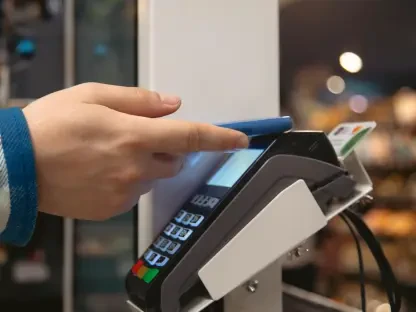In the dynamic world of retail, businesses are always seeking innovative methods to deeply understand customer behaviors and optimize their services. At the forefront of this exploration is Computer Vision, an influential technology set to alter the conventional dynamics between retailers and consumers significantly. This tech adeptly captures subtle purchasing behaviors, offering a lens through which retailers can observe and analyze consumer interactions more intricately. The deployment of Computer Vision paves the way for a more tailored shopping journey, ensuring that customer experiences are significantly enhanced. By leveraging detailed insights into shopper activities, retailers can fine-tune their operations, strategize more effectively, and curate experiences that resonate more profoundly with customer needs. Thus, Computer Vision stands as a transformative element in the retail landscape, propelling businesses towards more intelligent and responsive customer engagement.
Understanding Consumer Behavior With AI-Enhanced Vision
The Rise of Computer Vision in Retail
Computer Vision, powered by artificial intelligence, has evolved into an indispensable asset for the retail sector. It grants a window into the ways customers interact with merchandise, uniting the analytical realms of online and offline commerce. Retailers can harness the insights from AI algorithms and camera systems to restructure store layouts and fine-tune marketing strategies, propelling sales-forward trajectories and deepening customer loyalty.Retailers embracing Computer Vision find themselves at a strategic advantage, as they can also better manage inventory and enhance the in-store customer journey. The data collected informs not just what products sell, but how and why certain items capture consumer attention, facilitating a data-driven approach to product placement and store atmosphere.
Market Growth and Predictions
The Computer Vision market is set to surge, reaching an anticipated $411 billion by the end of the decade. This substantial growth highlights the critical role of AI solutions in the evolving retail landscape. Faced with stiff competition and the growth of online shopping, retailers are increasingly turning to these technologies to stay relevant and competitive. The push towards integrating Computer Vision signals a broader strategic pivot wherein data analytics, particularly relating to consumer behavior, is becoming central to retail success. Businesses are understanding that leveraging data is key to understanding and catering to consumer preferences, thereby driving innovation and growth in the sector. As the sector expands, companies not adopting these AI-driven analytical tools may find themselves at a disadvantage, pressured by the new data-centric approach that is shaping the future of retail.
Retail Space Optimization and Loss Prevention
Increasing Sales Efficacy Through Data
Using Computer Vision in retail leverages vast data to refine store layouts, leading to enhanced sales. This technology gathers detailed information on how customers engage with the space and products, enabling stores to reorganize for maximum efficiency and satisfaction. Retailers analyze customer behavior data, making strategic adjustments to store design and product placement. This not only boosts sales but also creates a shopping environment that feels personalized and inviting to consumers.Personalization goes further, as retailers can adapt their strategies to match individual preferences, fostering a sense of understanding and increasing the likelihood of repeat visits. This data-driven customization surpasses the effectiveness of general marketing by directly appealing to consumer desires. Thus, Computer Vision empowers retailers to create highly optimized and customer-centric retail spaces.
Mitigating Risks With Real-Time Monitoring
Computer Vision technology has revolutionized the way retail loss prevention is managed. With its capability for real-time monitoring, the technology acts as a vigilant protector against the risk of theft. This advanced system can promptly detect unusual behavior that typically signals theft, allowing for immediate action to be taken to prevent or reduce any potential loss. This results in a significant enhancement in security for retailers. Instead of relying on uncertain predictions or traditional surveillance methods, retailers can now depend on precise and immediate alerts driven by concrete evidence of suspicious activity. Consequently, this empowers retail owners with a more robust and data-driven approach to maintaining the integrity and safety of their store environments. By utilizing Computer Vision, retail operations are empowered to prevent loss more effectively and with greater confidence, ensuring the security of their assets through technology-driven vigilance.
Advances in Retail Operations and Consumer Engagement
Elevating Omnichannel Retail Strategies
Computer Vision is essential in the evolution of omnichannel retail, aligning the customer experience across different channels. This technology helps maintain consistent satisfaction regardless of how customers engage with a brand. Retailers must extend the personalized touch from physical stores to digital spaces to provide a coherent brand experience.The integration of online and in-store experiences through Computer Vision ensures a singular narrative is presented to shoppers, regardless of their shopping mode. It creates a data-backed consistency, strengthening the bond between the customer and the brand. By doing so, retailers present a unified image that resonates steadily with customers every time they interact with the brand, ensuring the customer journey is uninterrupted and equally gratifying in all shopping environments. The goal is to deliver a persistent and unvarying brand message that fosters loyal customer relationships through seamless multichannel integration.
Impact on Personalized Marketing and Shopping Experiences
The meticulous insights provided by Computer Vision furnish retailers with the means to enact highly personalized marketing campaigns. A nuanced understanding of shopper behavior allows for marketing endeavors tailored to individual preferences, ensuring that promotions resonate on a more intimate level. Additionally, digital vision technologies are shaping the in-store environment, enabling interactive displays and personalized recommendations that mirror the convenience and sophistication of online shopping.In-store experiences augmented by Computer Vision offer retailers the opportunity to dazzle customers with a curated environment responsive to their behavior. Through interactive displays and smart technology, the physical store can evolve into an enthralling space that caters to customer inclinations, solidifying the store’s role as a cornerstone of retail engagement.
Contactless Shopping and Emerging Consumer Trends
The Shift Towards Touch-Free Interactions
In this digital age, the rise of touchless transactions is a hallmark of innovation allied with safety. Computer Vision is at the forefront, driving this change by enabling contactless payments through facial recognition. This technology responds to the increasing desire for quick, secure ways to pay, highlighting a trend towards convenient solutions heightened by health and safety needs.Shops are responding to the trend for less contact by adopting faster checkout systems that simplify the buying process. These advancements cut down on wait times and provide a smoother, more efficient shopping experience that customers appreciate. The shift to these futuristic payment options not only fulfills current health precautions but also aligns with a digital-first consumer landscape.The embrace of contactless technology through Computer Vision marks a significant progression in how transactions are handled, merging safety with efficiency in today’s retail spaces.
The Role of Facial Recognition in Retail Settings
Facial recognition technology, steeped in Computer Vision applications, is becoming commonplace in retail, serving purposes that extend beyond payment processing. It enhances store security by enabling identification and access control, while also potentially providing personalized shopping experiences as customers move through the store. The integration of this technology marks a step towards future-focused retail practices that prioritize speed, safety, and customization.The deployment of facial recognition in stores illustrates the balance between technology and customer care, streamlining operations while enriching the shopping journey. Its utility shines not just in transactions but in how it personalizes the shopping experience—acknowledging regular customers and suggesting products in alignment with their shopping history, thus merging convenience with a personal touch.
Navigating Privacy Concerns and Addressing Challenges
Privacy Considerations and Data Protection Regulations
As Computer Vision technologies weave into the fabric of retail operations, their expansion comes at the crossroads of innovation and privacy. Retailers must conscientiously navigate data protection laws, ensuring that camera-derived insights comply with shifting regulations. The obligation to deploy these solutions responsibly falls heavily on businesses, who must balance the drive for customer insights with the imperative of moral data stewardship.Ethical utilization of Computer Vision demands transparency and integrity in how consumer data is collected, processed, and preserved. This stewardship is fundamental not only to legal conformity but to the preservation of consumer trust, which acts as the bedrock of successful retail ventures. By prioritizing privacy, retailers reinforce their reputations and fortify customer relationships.
Ensuring Equity and Accuracy in Algorithms
Reliance on AI necessitates a critical examination of the algorithms that underpin Computer Vision, ensuring they deliver impartial and precise insights. The challenge is to cultivate AI that reflects equity, actively preventing biased data interpretation that could lead to discriminatory outcomes. Retailers bear the responsibility for this, as their decisions based on these technologies can have profound implications for their customers.It is essential to continuously audit and refine the algorithms to avoid reinforcing existing prejudices and to validate that the insights obtained serve the diverse demographics that comprise the retail customer base. Achieving accuracy and fairness in this technology is not only a technical imperative but a moral one, signifying a retailer’s commitment to equitable consumer treatment.
Balancing Technology Benefits with Operational Considerations
The Advantages of Embracing Computer Vision
Computer Vision technology is revolutionizing the retail sector by providing a host of benefits that streamline operations and boost customer engagement. This cutting-edge tech is pivotal for live analytics, improving stock control, and reducing theft, thereby promoting a safer, more efficient shopping environment.Retailers leveraging Computer Vision can monitor inventory with precision, glean insights on product trends, and refine the stocking process, which eliminates inefficient practices seen in traditional methods. This forward-thinking approach ensures retailers remain agile, data-driven, and focused on delivering personalized shopping experiences that foster lasting customer loyalty.By harnessing the power of Computer Vision, the retail landscape is transformed into one that is proactive, rich in insights, and tailored to the consumer’s needs. Retailers are thus fortified with the strategic advantage to navigate the market with greater confidence and success.
Critical Reflections on Technology Adoption
The integration of Computer Vision in retail is not without its tribulations, including concerns such as the high costs of implementation and the risks associated with an over-reliance on technology. The possibility of workforce displacement due to increased automation also looms as a contentious issue. Retailers must carefully weigh these considerations, seeking a delicate balance that magnifies the technology’s benefits without forsaking human elements or customer trust.Incorporating Computer Vision must be a strategic choice—calibrated to elevate the customer experience while recognizing the limitations and implications of such technology. Retailers need to assess the myriad facets of adoption—the financial, ethical, and operational—to ensure the technology serves as an extension of their brand’s promise rather than a detriment to their legacy.









